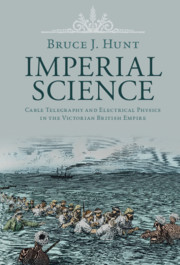'Lucid, brilliantly well-informed and replete with fresh insights, Imperial Science is destined to be an indispensable classic. Bruce J. Hunt gives us a rich account of how radical developments in cable telegraphy and the theory of electromagnetism were intertwined, with profound consequences for the everyday lives of millions of people all over the world.'
Graham Farmelo - Churchill College, University of Cambridge
'Well before the internet, information flowed through British submarine cable telegraphy. Bruce J. Hunt’s fascinating study explores how physicists and telegraph engineers managed competing methods and demands to create this first global communications system. These nerves of empire transformed international affairs, accelerated commerce, provided rapid access to news, and revolutionized physics.'
Kathryn Olesko - Georgetown University
'With impressive skill, Bruce J. Hunt brings together the commercial and engineering practices of Victorian telegraphy with the construction of the new physics of electromagnetic field theory. In so doing, he powerfully reinvigorates the history of nineteenth-century physics as a major academic arena grounded upon, but not determined by, imperial engineering and technology.'
Crosbie Smith - University of Kent
‘Illustrated with period images and impeccably referenced, Hunt's remarkable, scholarly text will encourage nonspecialist readers to engage … Highly recommended.’
E. J. Delaney
Source: Choice Connect
'In this important book our foremost historian of British telegraphy and Maxwellian electromagnetic field theory gives a compelling account of the intimate relation of telegraph engineering and mathematical physics over some forty years.’
M. Norton Wise
Source: Metascience
'Hunt’s book contributes to a historiography which already consists of excellent works ... The added value of the book is in providing evidence, as no other authors have done so far, of the technological steps leading to the great telegraph connection across the Atlantic and later around the world. Hunt also makes the various themes understandable to non-experts, building a compelling and well-illustrated narrative.'
Andrea Giuntini
Source: Technology and Culture



